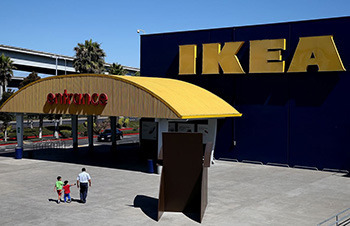4 Brainwashing Tactics IKEA Uses From the Cult Handbook
We normally associate the term "brainwashing" with Elizabeth Smart, cults, and self-help gurus. But one of the most powerful and financially harmful brainwashing campaigns of all time is currently being carried out by the last organization you'd expect: the minimalist Swedish furniture super-store known as IKEA.

This is how Sweden invades a country.
People love IKEA. They really love it. They love it more than Jesus, even, if you take into account that more copies of the IKEA catalog are printed than the Bible.
None of this happens by accident, either. From the moment we step inside, IKEA deploys sly manipulation tactics meant to lure us into purchasing shit we don't need. Everything from the smell of their trademark meatballs to their bookshelves with goofy names we can't pronounce is a calculated decision made in the name of nothing else than lightening your wallet. Here's how they do it ...
They Isolate You From Other Stores

Quick! Think about all of the trips you've make to IKEA in your life! Now, quit crying for a moment and ask yourself this: when is the last time you walked out of IKEA and directly into another store without getting in your car and driving? That rarely happens, if ever at all, because IKEA makes it a point to be in the middle of goddamn nowhere.
A trip to IKEA isn't a quick thing. It involves time and planning, like a trip to Disneyland or figuring out when it's safe to fart in front of your significant other. No one just "pops in" to IKEA as they would a grocery store or pharmacy. Those places are readily available, sometimes within walking distance. If you can walk to IKEA, you probably live at a TGI Friday's.

And probably not a "fun" one.
No matter where you are, the nearest IKEA is probably a 20-minute drive away and situated in the kind of bleak suburb you've always had nightmares about settling down in. This isolation from the city center and urban areas is more than just a bold declaration that corporate Sweden gives not one fuck about your free time -- it's also part of IKEA's marketing strategy.

Shockingly, that monkey in a furry coat was not.
According to the Center for Management Research, the idea involves more than just eliminating competition by literally forcing you to drive miles away from it; it also makes a trip to IKEA more of an "experience." Because very few people drive 20 minutes just to window shop (they don't have windows anyway), that experience will inevitably involve spending money on something you don't need. Sure, it might just be their $1 coffee and a jar of lingonberry sauce, but the fact remains: that's less money for you, more money for IKEA. And things only get worse when you get inside.
They Use Confusion and Chaos to Sell You Things You Don't Need

Ever walked into the infamous IKEA labyrinth only to leave three years later? That's not a design flaw. The company, which I'm going to call "the Nickelback of Swedish furniture" this time to avoid continually repeating its actual name, purposely wants to disorient you and make you feel like you're lost in a corn-maze. The idea is to keep you trapped for as long as possible with very few ways to escape that don't involve the temporary break from reality that comes with finding a "great deal" among the super-cheap items they strategically place around the store in the hopes you'll relieve your boredom and hopelessness with an impulse purchase or two. You know, stuff like light bulbs, batteries, or a stuffed wolf eating a stuffed grandma.

It's in 76 different pieces when you first open the box.
The possibilities are nearly endless and completely unimportant. IKEA just wants your money, be it from your purchase of a stuffed animal that's described as "good at listening" or otherwise.
The chaos of the floor layout is matched only by the crime scene that is the average IKEA product display, which tends to look like something best described as "a bunch of shit haphazardly tossed into a pile." You'd think shoppers would appreciate a neatly stacked display, but you would think wrong. If that were the case, rest assured IKEA would keep it accordingly tight. But studies show that displays consisting of disheveled piles of crap actually boost sales.

From the IKEA Sopor line.
Apparently, mountains of clutter project better deals. Some stores even pile up their merchandise and mess it up on purpose to make it look like it's in-demand and popular.
So, if you've ever wondered why the inside of every IKEA looks like it's maintained by a crew of kindergartners, the answer is simple -- it's because you love that shit.
They Use the Smell of Food to Sell You More Than Food
Let's be honest, most of us wouldn't be able to identify Swedish food of any sort if it wasn't for IKEA's iconic Swedish marketplace. In 2012, the very height of their pre-horse-meat-controversy golden age, the multidimensional retailer sold 150 million of their signature meatballs. That's roughly 4,200 metric tons of Seabiscuit.

Shoutout to delicious Swedish horses.
But the food isn't there to promote cultural awareness only (or at all). IKEA knows the fastest way to our wallets is through our stomachs, and the statistics back that up. The food, and even the smell of the food, is simply a gateway drug that leads to you spending your entire paycheck on household furnishings that you and your significant other will expend untold weekend hours building and fighting over until the habit ultimately tears you asunder.
Sure, "scent marketing" is a psychological sensory weapon many stores have used for a long time now. You can avert your eyes, but you can't stop inhaling the sweet aroma of cinnamon buns and such. Few companies wield this weapon quite as effectively as IKEA, though. Not content to let the scent of sizzling thoroughbred just waft through the aisles unassisted, they actually pump the smell of cooked meat into their kitchen display sections, just as a reminder of all the delicious things you could be cooking with that pan you've been eyeing for no discernible reason.

His name is Trovardig!
Those meatballs you damn well know you're buying aren't just going to cook themselves, right? Besides, who drives 20 minutes just to buy meatballs? You'd look like a crazy person if you didn't pick up a little cookware while you're all the way out there.
Plus, Ikea deliberately plants their restaurants and cafes smack dab in the middle of their maze. The constant availability of food keeps us satiated, energized, and, most importantly, happy. Happy people are slightly less vigilant and more likely to spend money on plastic wood.

Assembling this will destroy you.
It's not until you furnish your studio apartment with IKEA goods, only to find that it smells less like delicious sausage and more like packing peanuts, that the reality of what just happened sets in.
"The IKEA Effect" Makes All the Effort Seem Worth It

IKEA has a reputation for selling furniture that comes with the kind of instructions you'd expect to see if you were building an elaborate bomb or entry-level robot. Everyone knows that, but for some reason, countless first-time customers flock to the IKEAs of the world every single day to dip their toes in the punishing waters of extreme self-assembly.

You do not need this shit.
Even more mind-blowing is that, conceivably, a sizable portion of the IKEA customer base consists of people who are returning a second and third time (at least), despite having firsthand knowledge of the devastating effects a decision like that will have on their sanity and free time.
It seems insane, but there's science behind how and why it happens. See, if and when you actually finish building that Jerker, you'll love it and appreciate it way more because you put it together.
Even if you did a crappy job assembling it and it falls apart within a few months, you'll still take pride in that useless piece of trash. Why? Because we're all narcissistic shitheads like that. Take your children, for example.

Ugh.
They might be (and almost certainly are) just as annoying or even more obnoxious than anybody else's kids, but you still like them the most because you made them.
IKEA has taken this concept to staggering new heights, as evidenced by the fact that the idea of do-it-yourself-products-as-marketing-tools is actually referred to in some circles as "The IKEA Effect."

The first symptom is unconsciousness.
Coming away from any task with the sense that you've accomplished something tangible and real is going to feel like a win. Again, take your shitty kids for example: they might instinctively kick and scream at the sight of vegetables, but if you ask them to participate in preparing and cooking a meal with those vegetables, they'll probably eat them just because they're curious how this thing they helped build will taste.
People will always like stuff they put their work and time into, even if it's shitty. IKEA exploits this better than anyone by making you work the hardest for their products. It's a nightmare while you're in the midst of the project, but once you're finished, you feel like you've done something not everyone has the ability to do. You saw that mountain, you climbed it, and you've got a rickety-ass bookshelf to prove it.
Congratulations, master builder!
For more from Eden, follow her on Twitter @eden_eats.
For more ways you're getting fleeced, check out 21 Tricks Stores Use to Control Your Brain and 6 Subtle Ways You're Getting Screwed at the Grocery Store.
Charlie stumbled onto something big happening inside an abandoned warehouse. Specifically, SOMEONE big: Bruce, a twenty-foot-tall teenage giant, who Charlie must keep a secret. Check out Chris Pauls and Matt Solomon's The Giant Smugglers!








